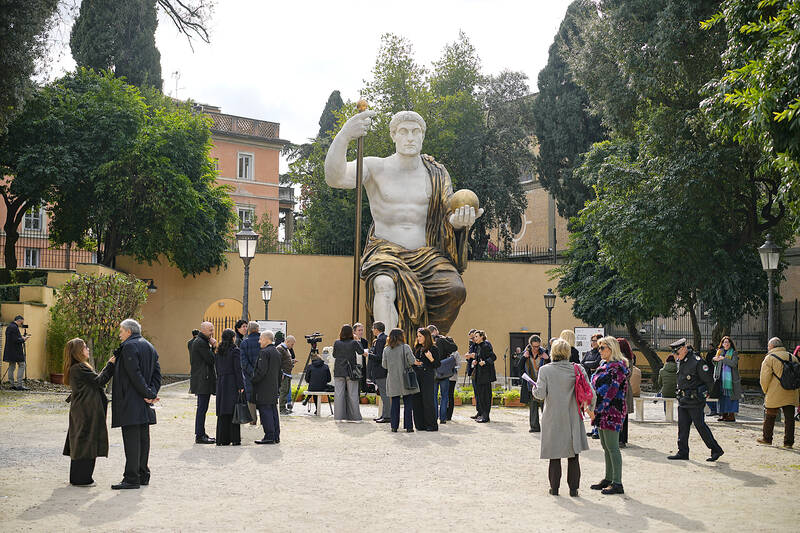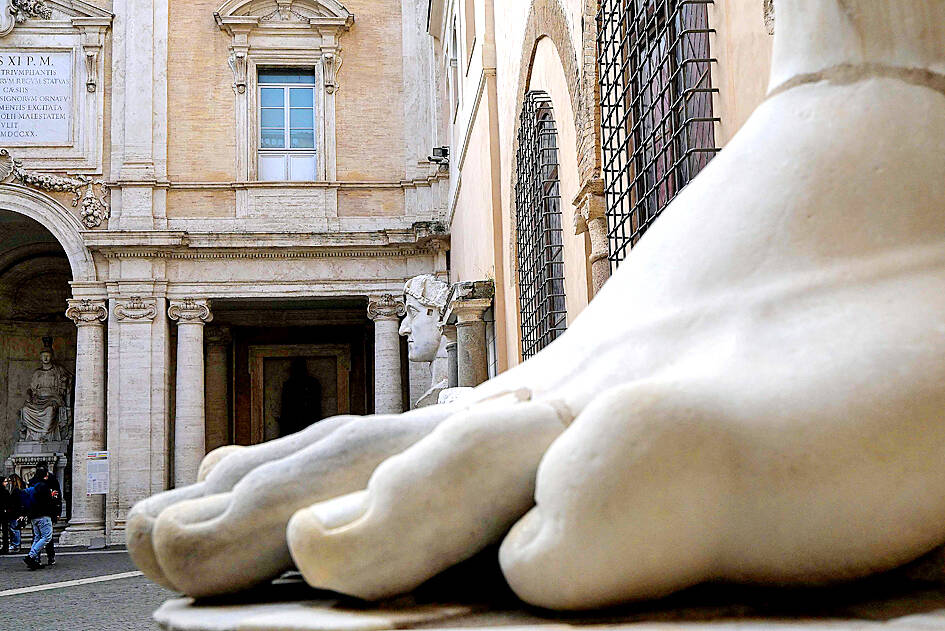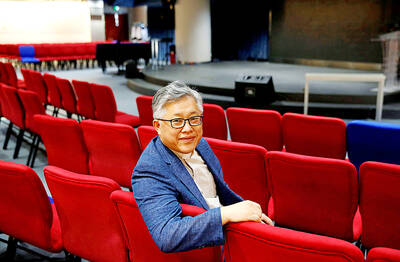Emperor Constantine, the fourth-century ruler whose embrace of Christianity helped spread the faith throughout the Roman Empire, now has a reconstructed statue befitting his larger-than-life role in history.
Rome authorities on Tuesday unveiled a massive 13m replica of the statue Constantine commissioned for himself after 312 AD. It was imagined using 3D modeling technology from scans of the nine giant original marble body parts that remain.
The result: An imposing figure of a seated emperor, draped in a gilded tunic and holding a scepter and orb, gazing over his Rome from a side garden of the Capitoline Museums. The reconstructed statue is just around the corner from the museum courtyard where the original fragments of Constantine’s giant feet, hands and head are prime tourist attractions.

Photo: AP
Reconstituted into its original whole, the statue inspires awe in the smaller viewers below — just as Constantine originally intended for his subjects, officials said at the unveiling.
“In this statue there’s not just beauty, there’s the violence of power,” said Salvatore Settis, an archeologist and art historian who is on the steering committee of the Fondazione Prada, the cultural and educational arm of the Milan-based fashion house which financed the project.
Officials declined to say how much the initiative cost, but the replica was made by the Factum Foundation, a Madrid-based nonprofit that creates high-resolution digital replicas of the world’s cultural patrimony.

Photo: Tiziana Fabi, AFP
“This whole dynamic about how you use technology to transform our understanding of and the importance of cultural heritage is the core mission of Factum Foundation,” group founder Adam Lowe said.
The statue itself is made from resin, polyurethane and marble powder for the body, and gold leaf and plaster for the gilded tunic that drapes over it.
A second version of the statue is to be installed in northeast England, where Constantine guarded the Hadrian’s Wall fortification before being crowned emperor in Rome.

STEPPING UP: Diminished US polar science presence mean opportunities for the UK and other countries, although China or Russia might also fill that gap, a researcher said The UK’s flagship polar research vessel is to head to Antarctica next week to help advance dozens of climate change-linked science projects, as Western nations spearhead studies there while the US withdraws. The RRS Sir David Attenborough, a state-of-the-art ship named after the renowned British naturalist, would aid research on everything from “hunting underwater tsunamis” to tracking glacier melt and whale populations. Operated by the British Antarctic Survey (BAS), the country’s polar research institute, the 15,000-tonne icebreaker — boasting a helipad, and various laboratories and gadgetry — is pivotal to the UK’s efforts to assess climate change’s impact there. “The saying goes

Floods on Sunday trapped people in vehicles and homes in Spain as torrential rain drenched the northeastern Catalonia region, a day after downpours unleashed travel chaos on the Mediterranean island of Ibiza. Local media shared videos of roaring torrents of brown water tearing through streets and submerging vehicles. National weather agency AEMET decreed the highest red alert in the province of Tarragona, warning of 180mm of rain in 12 hours in the Ebro River delta. Catalan fire service spokesman Oriol Corbella told reporters people had been caught by surprise, with people trapped “inside vehicles, in buildings, on ground floors.” Santa Barbara Mayor Josep Lluis

Police in China detained dozens of pastors of one of its largest underground churches over the weekend, a church spokesperson and relatives said, in the biggest crackdown on Christians since 2018. The detentions, which come amid renewed China-US tensions after Beijing dramatically expanded rare earth export controls last week, drew condemnation from US Secretary of State Marco Rubio, who on Sunday called for the immediate release of the pastors. Pastor Jin Mingri (金明日), founder of Zion Church, an unofficial “house church” not sanctioned by the Chinese government, was detained at his home in the southern city of Beihai on Friday evening, said

TICKING CLOCK: A path to a budget agreement was still possible, the president’s office said, as a debate on reversing an increase of the pension age carries on French President Emmanuel Macron yesterday was racing to find a new prime minister within a two-day deadline after the resignation of outgoing French Prime Minister Sebastien Lecornu tipped the country deeper into political crisis. The presidency late on Wednesday said that Macron would name a new prime minister within 48 hours, indicating that the appointment would come by this evening at the latest. Lecornu told French television in an interview that he expected a new prime minister to be named — rather than early legislative elections or Macron’s resignation — to resolve the crisis. The developments were the latest twists in three tumultuous